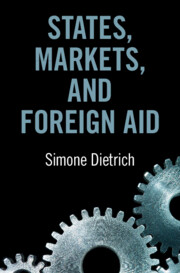Book contents
- States, Markets, and Foreign Aid
- States, Markets, and Foreign Aid
- Copyright page
- Dedication
- Contents
- Figures
- Tables
- Preface and Acknowledgements
- 1 Understanding Donor Pursuit of Foreign Aid Effectiveness
- 2 How National Structures Shape Foreign Aid Delivery
- 3 Examining the Causal Mechanism across Donors
- 4 Country-Level Evidence Linking Donor Political Economies to Variation in Aid Delivery
- 5 Testing the Argument with Evidence from Aid Officials from the United States, United Kingdom, Sweden, Germany, France, and Japan
- 6 Examining Public Opinion as an Alternative Explanation
- 7 Implications for Aid Effectiveness, Public Policy, and Future Research
- Bibliography
- Index
2 - How National Structures Shape Foreign Aid Delivery
A Theory
Published online by Cambridge University Press: 29 October 2021
- States, Markets, and Foreign Aid
- States, Markets, and Foreign Aid
- Copyright page
- Dedication
- Contents
- Figures
- Tables
- Preface and Acknowledgements
- 1 Understanding Donor Pursuit of Foreign Aid Effectiveness
- 2 How National Structures Shape Foreign Aid Delivery
- 3 Examining the Causal Mechanism across Donors
- 4 Country-Level Evidence Linking Donor Political Economies to Variation in Aid Delivery
- 5 Testing the Argument with Evidence from Aid Officials from the United States, United Kingdom, Sweden, Germany, France, and Japan
- 6 Examining Public Opinion as an Alternative Explanation
- 7 Implications for Aid Effectiveness, Public Policy, and Future Research
- Bibliography
- Index
Summary
Chapter 2 develops the principal claim of the book, which posits that foreign aid delivery is endogenous to national structures. The chapter begins with a brief historical account of how patterns of foreign aid delivery have evolved since the end of World War II. It then fleshes out three theoretical and empirically informed observations about aid decision-making: (1) that aid officials, as key decision-makers, seek to minimize risk in aid delivery, that (2) their response to risk is conditional on the rules and practices that make up the national aid organizations in which they operate, and (3) that these rules and practices have ideological origins that inform us about the substance of aid delivery: why it is that aid officials choose to bypass or engage with the recipient government.
Keywords
- Type
- Chapter
- Information
- States, Markets, and Foreign Aid , pp. 39 - 76Publisher: Cambridge University PressPrint publication year: 2021

